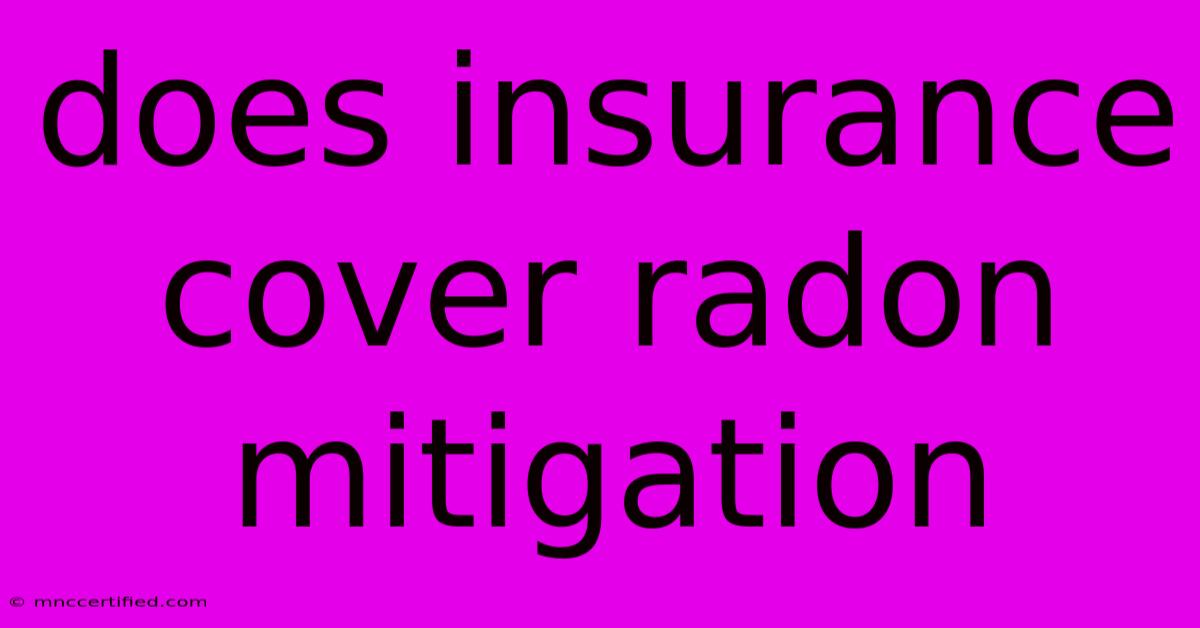Does Insurance Cover Radon Mitigation

Table of Contents
Does Insurance Cover Radon Mitigation? A Comprehensive Guide
Radon is a colorless, odorless, and tasteless radioactive gas that can seep into your home from the ground. It's a serious health hazard, as long-term exposure can increase your risk of lung cancer. While radon mitigation systems can help protect you and your family, the question of whether insurance covers the cost can be a significant factor in your decision.
The Short Answer:
No, insurance policies typically don't cover the cost of radon mitigation. However, there are some exceptions and things to consider.
Why Insurance Companies Usually Don't Cover Radon Mitigation:
- Radon is not a covered peril: Most standard homeowners insurance policies cover damage from events like fire, wind, or hail. Radon, being a naturally occurring gas, isn't considered a covered peril.
- Prevention vs. Repair: Insurance typically covers repairs after a covered event, not preventive measures. Radon mitigation aims to prevent future health issues, not repair existing damage.
- Varying Risk Levels: Radon levels can vary significantly across locations. Insurance companies might be hesitant to cover radon mitigation for everyone, as the risk is not universally high.
Exceptions and Considerations:
- Some Policies Might Offer Coverage: Check your individual insurance policy for specific details. A few policies may offer limited coverage for radon mitigation, especially if it's required by local building codes or if the house was built in a radon-prone area.
- Mortgage Requirements: In some cases, your mortgage lender might require radon mitigation before approving a loan, especially if the home is located in a high-risk area. Contact your lender for more information.
- FHA Loans: The Federal Housing Administration (FHA) requires radon mitigation for homes with high levels of radon. If you're considering an FHA loan, be aware of these requirements.
- Health Issues: If you or someone in your family has been diagnosed with lung cancer and radon exposure is suspected as a contributing factor, your insurance company might be more likely to cover mitigation costs.
What Can You Do?
- Test Your Home: The first step is to test your home for radon. You can buy test kits online or at hardware stores. Follow the instructions carefully and send the kit to a certified laboratory for analysis.
- Consult With a Radon Mitigation Specialist: If your radon levels are elevated, consult with a certified specialist. They can assess your situation and recommend appropriate mitigation measures.
- Consider Cost-Benefit Analysis: Radon mitigation systems can vary in cost, but they can provide peace of mind and significantly reduce your risk of lung cancer. Weigh the cost of mitigation against the potential health benefits.
Remember: Even if your insurance doesn't cover radon mitigation, the cost is often significantly less than the potential health risks associated with prolonged radon exposure.
Key Takeaways:
- Insurance policies typically don't cover radon mitigation, but exceptions exist.
- Check your policy and contact your insurance provider for specific details.
- Consider FHA loan requirements and potential mortgage lender restrictions.
- Invest in testing and mitigation if necessary.
By understanding the ins and outs of insurance coverage and taking proactive steps, you can protect yourself and your family from the potential dangers of radon.

Thank you for visiting our website wich cover about Does Insurance Cover Radon Mitigation. We hope the information provided has been useful to you. Feel free to contact us if you have any questions or need further assistance. See you next time and dont miss to bookmark.
Featured Posts
-
Chalazion Surgery Cost With Insurance
Nov 10, 2024
-
Ice U S Treasury 20 Year Bond Index
Nov 10, 2024
-
Remembering The Brave Manchester Stands Strong
Nov 10, 2024
-
Best Travel Insurance For New Zealand
Nov 10, 2024
-
Surrey 2024 Remembrance Sunday Services And Parades
Nov 10, 2024